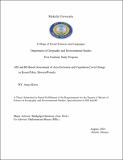| dc.description.abstract | Land degradation has been a major environmental problem in northern highlands of Ethiopia. Consequently, the degraded landscapes were poor to offer landscape services for the society. As part of the government responses, area exclosure has been implemented to halt land degradation and improve the sustainability of environmental resources in Tigray. Thus, the current study was conducted to assess the area exclosure and vegetation cover change and its impacts on the community in Koraro, eastern Tigray. The application of remote sensing, geographical information system and satellites imageries; Landsat4-5 TM (1984, 1995, 2000 and 2010) and land sat 8 (2014) were used to analyze land use and land cover dynamics and vegetation cover change. NDVI was considered to detect the vegetation cover change in the study area. Focus group discussion, interview and structured questionnaire were also used to investigate impacts of area exclosure on the livelihood of the farmers. The major land use land cover types in the study area were identified as farmlands, settlements, vegetated area and bare lands. The land use land cover types in Koraro have changed in the last 30 years. The NDVI value shows an increasing trend due to the introduction of area exclosure. In this regard, the NDVI value for 1984 and 2014 are 0.140 and 0.20 respectively. Moreover, the study shows that area exclosure has positive response to the availability of fodder, firewood and farmland productivity. This indicates that livelihood of the community is partly improved due to the presence of area exclosure. However, some of the respondents were resistant for further expansion and implementation of area exclosure, indicating further work is needed to convince them. All in all, this study confirms that area exclosure is an important rehabilitation tool to restore the degraded landscape and thereby improve the lives of the poor farmers. This indicates that the expansion of area exclosure to the rest degraded areas is an important option to bring back our wastelands into economically active land. Therefore, area exclosure should be expanded to other areas where soil erosion and forest degradation persists by considering the socio-economic of the local communities. | en_GB |


